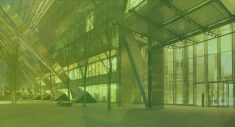The explosion of global interest in circular economy follows the adoption of the wellbeing and sustainability agenda by building designers, architects and facility managers. In March 2020, the European Commission’s published a strategic action plan to pave the effective transition from a linear industry model towards a resource efficient circular model.
For architects, designers and developers, this will mean a new way of approaching the selection of sustainable materials and components for new builds and retrofits. Find out how to meet circular economy criteria while specifying materials for your LEED, BREEAM and WELL projects.
Linear construction approach
Sustainable buildings perform better, using less energy and water resources. Along with a lower environmental impact, sustainable buildings also offer healthier and more comfortable indoor environments where we live, work and play. And they are relatively cheaper to run as well as they are considered more valuable assets.
However, to successfully advance the building sector towards a resource efficient circular model, we should move away from the traditional linear construction process. Such linear approach, which is generally follow by the industry, is known as ‘take, make, and waste’: materials are extracted, used and then thrown away at end-of-life as waste.

The built environment is still the most resource consuming sectors in Europe and in the word, accounting for half of all extracted materials. In addition, construction and demolition waste represent one third of total waste generation in the EU waste generation. So, much more has to be done in order to reduce and recycle such large amount of waste in Europe.
The misconception of being able to rely on infinite and cheap natural resources has enabled this approach to endure. But, as the world’s population grows and resources become harder and more expensive to access, it is becoming ever more critical to find alternative means of sourcing and using materials. As a result, it appears clear to all that we need to shift towards a more efficient circular model.
Circular economy and sustainable building
“The circular economy model entails gradually decoupling economic activity from the consumption of finite resources, and designing waste out of the system.”
Ellen MacArthur Foundation
According to the principles of the circular economy everything is designed to be constantly reused or recycled. The above requires the whole rethinking of design, manufacturing, selling, re-using, recycling process including the consumer ownership, in order to keep resources in use for as long as possible and to extract maximum value.

In a circular economy environment, manufacturers design products to be reusable. For example, electrical devices are designed in such a way that they are easier to repair. Products and raw materials are also reused as much as possible.
Deciding whether to reuse, refurbish or demolish an existing building becomes also critical when also seen from a circular economy, and sustainability, prospective. Smart demolition (dismantling) may offer high-grade used building materials for reuse and recycling. But this requires building materials and components to be designed for recycling and reuse.
Masterclass: circular economy of green products
On May 5, sustainable building material experts Alfonso Senatore, CEO of Ongreening, and Peter Templeton, CEO of the Cradle to Cradle Products Innovation Institute, will deliver an international Masterclass on the circular economy of the green products.
Alfonso Senatore and Peter Templeton will talk you through:
- Principles of the circular economy;
- Key aspects of materials, products and systems for the built environment;
- How to select building products to meet circular economy criteria;
- What to consider when specifying materials for LEED, BREEAM and WELL projects;
- Green Public Procurement and circular economy;
- C2C Certified framework and Product Circularity impact category;
- Life Cycle Assessment (LCA) of building materials.
The event will be facilitated by Mario Pinoli, principal of Greenwich.
The masterclass on circular economy of green products is part of a 2-day high-profile online training dedicated to the community of green professionals, which is hosted by the Green Building Council Italia in early May.
The webinar will end with a Q&A so you make sure to grab the chance to ask your question about the topics that come up. LEED Green Associate and LEED/WELL/SITES professionals will earn 1,5 Continuing education (CE) Hours.
So, what are you waiting for? Sign up for the webinar and tune in on Wednesday 05 May at 14.00 – 15.30 (CEST).




